Mapping Re-Naturalization Pathways for Urban Ecological Governance: A Spatial Decision-Support Framework Based on Ecosystem Service Valuation
Abstract
1. Introduction
2. Materials and Methods
2.1. Study Area
2.2. Framework
2.3. Future Development Scenarios Simulation
2.4. Ecosystem Services Evaluation and Valuation
2.5. Developing Re-Naturalization Pathways
2.6. Data Collection
3. Results
3.1. Spatial and Temporal Changes of Ecosystem Service Value (2000–2020)
3.2. Growth Probability Distributions for Various Land Use Types
3.3. Land Use Distribution Patterns Under Different Development Scenarios
3.4. Differences in Ecosystem Service Values Under Various Land Development Scenarios
3.5. Land Re-Naturalization Pathways Under Optimal Development Scenarios
4. Discussion
5. Conclusions
Supplementary Materials
Author Contributions
Funding
Data Availability Statement
Acknowledgments
Conflicts of Interest
References
- Mahtta, R.; Fragkias, M.; Güneralp, B.; Mahendra, A.; Reba, M.; Wentz, E.A.; Seto, K.C. Urban land expansion: The role of population and economic growth for 300+ cities. npj Urban Sustain. 2022, 2, 5. [Google Scholar] [CrossRef]
- UN-Habitat. World Cities Report 2022: Envisaging the Future of Cities; UN-Habitat: Nairobi, Kenya, 2022. [Google Scholar]
- Saiedlue, S.; Hosseini, S.B.; Yazdanfar, S.A.; Maleki, S.N. Enhancing Quality of Life and Improving Living Standards through the Expansion of Open Space in Residential Complex. Procedia-Soc. Behav. Sci. 2015, 201, 308–316. [Google Scholar] [CrossRef][Green Version]
- Yang, L.; Chen, W.; Fang, C.; Zeng, J. How does the coordinated development of population urbanization and land urbanization affect residents’ living standards? Empirical evidence from China. Cities 2024, 149, 104922. [Google Scholar] [CrossRef]
- Chen, H.; Yu, J.; Ma, S.; Zhang, W. Urban scale, production efficiency, and dynamic development paths. Cities 2023, 143, 104566. [Google Scholar] [CrossRef]
- Zhang, H.; Zheng, J.; Hunjra, A.I.; Zhao, S.; Bouri, E. How does urban land use efficiency improve resource and environment carrying capacity? Socio-Econ. Plan. Sci. 2024, 91, 101760. [Google Scholar] [CrossRef]
- Gao, Y.; Shi, X.; Zhang, H.; Tang, R. Optimized Resource Allocation for Sustainable Development in Beijing: Integrating Water, Land, Energy, and Carbon Nexus. Land 2024, 13, 1723. [Google Scholar] [CrossRef]
- Hu, Y.n.; Connor, D.S.; Stuhlmacher, M.; Peng, J.; Turner Ii, B.L. More urbanization, more polarization: Evidence from two decades of urban expansion in China. npj Urban Sustain. 2024, 4, 33. [Google Scholar] [CrossRef]
- Cai, W.; Shu, C.; Lin, L. Integrating Ecosystem Service Values into Urban Planning for Sustainable Development. Land 2024, 13, 1985. [Google Scholar] [CrossRef]
- Wei, H.; Zhang, Y. Analysis of Impact of Urbanization on Environmental Quality in China. China World Econ. 2017, 25, 85–106. [Google Scholar] [CrossRef]
- Aghaloo, K.; Sharifi, A.; Habibzadeh, N.; Ali, T.; Chiu, Y.-R. How nature-based solutions can enhance urban resilience to flooding and climate change and provide other co-benefits: A systematic review and taxonomy. Urban For. Urban Green. 2024, 95, 128320. [Google Scholar] [CrossRef]
- Lin, X.; Wang, Y.; Song, L. Urbanization Amplified Compound Hot Extremes Over the Three Major Urban Agglomerations in China. Geophys. Res. Lett. 2024, 51, e2023GL106644. [Google Scholar] [CrossRef]
- Yan, H.; Li, Y.; Xing, Y.; Chen, X.; Guo, X.; Yin, Y.; Yu, W.; Huang, M.; Zhuang, J. Increasing human-perceived temperature exacerbated by urbanization in China’s major cities: Spatiotemporal trends and associated driving factors. Sustain. Cities Soc. 2025, 118, 106034. [Google Scholar] [CrossRef]
- Feng, R.; Wang, F.; Liu, S.; Qi, W.; Zhengchen, R.; Wang, D. Synergistic effects of urban forest on urban heat island-air pollution-carbon stock in mega-urban agglomeration. Urban For. Urban Green. 2025, 103, 128590. [Google Scholar] [CrossRef]
- Elliot, T.; Babí Almenar, J.; Rugani, B. Modelling the relationships between urban land cover change and local climate regulation to estimate urban heat island effect. Urban For. Urban Green. 2020, 50, 126650. [Google Scholar] [CrossRef]
- Ba, W.; Wang, D.; Gong, B.; Dai, Y.; Yang, Z.; Liu, Z. Urban water scarcity in China: A systematic review of research advances and future directions. Appl. Geogr. 2023, 159, 103069. [Google Scholar] [CrossRef]
- Li, W.; Hai, X.; Han, L.; Mao, J.; Tian, M. Does urbanization intensify regional water scarcity? Evidence and implications from a megaregion of China. J. Clean. Prod. 2020, 244, 118592. [Google Scholar] [CrossRef]
- Liang, L.; Wang, Z.; Li, J. The effect of urbanization on environmental pollution in rapidly developing urban agglomerations. J. Clean. Prod. 2019, 237, 117649. [Google Scholar] [CrossRef]
- Yang, L.; Ma, K.M.; Guo, Q.H.; Zhao, J.Z. Impacts of the urbanization on waters non-point source pollution. Huan Jing Ke Xue 2004, 25, 32–39. [Google Scholar]
- Simonson, W.D.; Miller, E.; Jones, A.; García-Rangel, S.; Thornton, H.; McOwen, C. Enhancing climate change resilience of ecological restoration—A framework for action. Perspect. Ecol. Conserv. 2021, 19, 300–310. [Google Scholar] [CrossRef]
- Prodanovic, V.; Bach, P.M.; Stojkovic, M. Urban nature-based solutions planning for biodiversity outcomes: Human, ecological, and artificial intelligence perspectives. Urban Ecosyst. 2024, 27, 1795–1806. [Google Scholar] [CrossRef]
- Frolking, S.; Mahtta, R.; Milliman, T.; Esch, T.; Seto, K.C. Global urban structural growth shows a profound shift from spreading out to building up. Nat. Cities 2024, 1, 555–566. [Google Scholar] [CrossRef]
- Russo, A.; Sardeshpande, M.; Rupprecht, C.D.D. Urban rewilding for sustainability and food security. Land Use Policy 2025, 149, 107410. [Google Scholar] [CrossRef]
- Perino, A.; Pereira, H.M.; Navarro, L.M.; Fernández, N.; Bullock, J.M.; Ceaușu, S.; Cortés-Avizanda, A.; van Klink, R.; Kuemmerle, T.; Lomba, A.; et al. Rewilding complex ecosystems. Science 2019, 364, eaav5570. [Google Scholar] [CrossRef]
- Tang, B.; Wang, H.; Liu, J.; Zhang, W.; Zhao, W.; Cheng, D.; Zhang, L.; Jiao, L. Identification of ecological restoration priority areas integrating ecological security and feasibility of restoration. Ecol. Indic. 2024, 158, 111557. [Google Scholar] [CrossRef]
- Bian, H.; Li, M.; Deng, Y.; Zhang, Y.; Liu, Y.; Wang, Q.; Xie, S.; Wang, S.; Zhang, Z.; Wang, N. Identification of ecological restoration areas based on the ecological safety security assessment of wetland-hydrological ecological corridors: A case study of the Han River Basin in China. Ecol. Indic. 2024, 160, 111780. [Google Scholar] [CrossRef]
- Jurjonas, M.; May, C.; Cardinale, B.; Kyriakakis, S.; Pearsall, D.; Doran, P. The perceived ecological and human well-being benefits of ecosystem restoration. People Nat. 2023, 6, 4–19. [Google Scholar] [CrossRef]
- Fedele, G.; Locatelli, B.; Djoudi, H. Mechanisms mediating the contribution of ecosystem services to human well-being and resilience. Ecosyst. Serv. 2017, 28, 43–54. [Google Scholar] [CrossRef]
- LopezDeAsiain, M.; Castro Bonaño, J.M.; Borrallo-Jiménez, M.; Mora Esteban, R. Urban socio-ecosystem renewal: An ecosystem services assessment approach. Int. J. Environ. Sci. Technol. 2024, 21, 2445–2464. [Google Scholar] [CrossRef]
- Ouyang, Z.; Zheng, H.; Xiao, Y.; Polasky, S.; Liu, J.; Xu, W.; Wang, Q.; Zhang, L.; Xiao, Y.; Rao, E.; et al. Improvements in ecosystem services from investments in natural capital. Science 2016, 352, 1455–1459. [Google Scholar] [CrossRef]
- Costanza, R.; d’Arge, R.; de Groot, R.; Farber, S.; Grasso, M.; Hannon, B.; Limburg, K.; Naeem, S.; O’Neill, R.V.; Paruelo, J.; et al. The value of the world’s ecosystem services and natural capital. Nature 1997, 387, 253–260. [Google Scholar] [CrossRef]
- Pereira, P.; Inácio, M.; Pinto, L.; Kalinauskas, M.; Bogdzevic, K.; Zhao, W. Mapping ecosystem services in urban and peri-urban areas. A systematic review. Geogr. Sustain. 2024, 5, 491–509. [Google Scholar] [CrossRef]
- Inácio, M.; Baltranaitė, E.; Bogdzevič, K.; Kalinauskas, M.; Valença Pinto, L.; Barceló, D.; Pereira, P. Mapping and assessing the future provision of lake ecosystem services in Lithuania. J. Environ. Manag. 2024, 372, 123349. [Google Scholar] [CrossRef]
- Amoroso, M.M.; Chillo, V.; Enríquez, A. Sustainable timber production in afforestations: Trade-offs and synergies in the provision of multiple ecosystem services in northwest Patagonia. For. Ecol. Manag. 2024, 574, 122345. [Google Scholar] [CrossRef]
- Medina-Roldán, E.; Lorenzetti, R.; Calzolari, C.; Ungaro, F. Disentangling soil-based ecosystem services synergies, trade-offs, multifunctionality, and bundles: A case study at regional scale (NE Italy) to support environmental planning. Geoderma 2024, 448, 116962. [Google Scholar] [CrossRef]
- de Knegt, B.; Lof, M.E.; Le Clec’h, S.; Alkemade, R. Growing mismatches of supply and demand of ecosystem services in the Netherlands. J. Environ. Manag. 2025, 373, 123442. [Google Scholar] [CrossRef]
- Hegetschweiler, K.T.; de Vries, S.; Arnberger, A.; Bell, S.; Brennan, M.; Siter, N.; Olafsson, A.S.; Voigt, A.; Hunziker, M. Linking demand and supply factors in identifying cultural ecosystem services of urban green infrastructures: A review of European studies. Urban For. Urban Green. 2017, 21, 48–59. [Google Scholar] [CrossRef]
- Deng, H.; Zhou, X.; Liao, Z. Ecological redline delineation based on the supply and demand of ecosystem services. Land Use Policy 2024, 140, 107109. [Google Scholar] [CrossRef]
- Campos, F.S.; David, J.; Lourenço-de-Moraes, R.; Rodrigues, P.; Silva, B.; Vieira da Silva, C.; Cabral, P. The economic and ecological benefits of saving ecosystems to protect services. J. Clean. Prod. 2021, 311, 127551. [Google Scholar] [CrossRef]
- Vaissière, A.-C.; Levrel, H.; Hily, C.; Le Guyader, D. Selecting ecological indicators to compare maintenance costs related to the compensation of damaged ecosystem services. Ecol. Indic. 2013, 29, 255–269. [Google Scholar] [CrossRef]
- Cui, L.; Shi, J. Urbanization and its environmental effects in Shanghai, China. Urban Clim. 2012, 2, 1–15. [Google Scholar] [CrossRef]
- Tian, Z.; Cao, G.; Shi, J.; McCallum, I.; Cui, L.; Fan, D.; Li, X. Urban transformation of a metropolis and its environmental impacts. Environ. Sci. Pollut. Res. 2012, 19, 1364–1374. [Google Scholar] [CrossRef] [PubMed]
- Sun, X.; Li, R.; Shan, X.; Xu, H.; Wang, J. Assessment of climate change impacts and urban flood management schemes in central Shanghai. Int. J. Disaster Risk Reduct. 2021, 65, 102563. [Google Scholar] [CrossRef]
- Wang, G.-X.; Liu, Y.-Y. A Correlation Analysis on the Growth of Population and Economy and Its Influence on Environment in Shanghai. 2006. Available online: https://en.cnki.com.cn/Article_en/CJFDTotal-FJDL200603007.htm (accessed on 1 February 2025).
- Maotian, L.; Finlayson, B.; Webber, M.; Barnett, J.; Webber, S.; Rogers, S.; Chen, Z.; Wei, T.; Chen, J.; Wu, X.; et al. Estimating urban water demand under conditions of rapid growth: The case of Shanghai. Reg. Environ. Change 2017, 17, 1153–1161. [Google Scholar] [CrossRef]
- Gao, C.; Feng, Y.; Wang, R.; Lei, Z.; Chen, S.; Tang, X.; Xi, M. 50-Year Urban Expansion Patterns in Shanghai: Analysis Using Impervious Surface Data and Simulation Models. Land 2023, 12, 2065. [Google Scholar] [CrossRef]
- Shanghai Land Resources “Tenth Five-Year Plan” and 2015 Long-Term Plan. Available online: https://hd.ghzyj.sh.gov.cn/xxgk/ghjh/200812/t20081223_144260.html (accessed on 1 February 2025).
- Strengthening the Use Control of Land Space and Strictly Abiding by the Red Line of Arable Land Protection. Available online: https://ghzyj.sh.gov.cn/nw2396/20221107/2fefca67cfeb42f78bed8cccbba918d6.html (accessed on 1 February 2025).
- Qian, X.; Shen, G.; Guo, C.; Gu, H.; Zhu, Y.; Wang, Z. Source apportionment and spatial heterogeneity of agricultural non-point source pollution based on water environmental function zoning. Trans. Chin. Soc. Agric. Eng. 2011, 27, 103–108. [Google Scholar]
- Dashtbozorgi, F.; Hedayatiaghmashhadi, A.; Dashtbozorgi, A.; Ruiz-Agudelo, C.A.; Fürst, C.; Cirella, G.T.; Naderi, M. Ecosystem services valuation using InVEST modeling: Case from southern Iranian mangrove forests. Reg. Stud. Mar. Sci. 2023, 60, 102813. [Google Scholar] [CrossRef]
- Benra, F.; De Frutos, A.; Gaglio, M.; Álvarez-Garretón, C.; Felipe-Lucia, M.; Bonn, A. Mapping water ecosystem services: Evaluating InVEST model predictions in data scarce regions. Environ. Model. Softw. 2021, 138, 104982. [Google Scholar] [CrossRef]
- Han, B.; Ouyang, Z. The comparing and applying Intelligent Urban Ecosystem Management System (IUEMS) on ecosystem services assessment. Acta Ecol. Sin. 2021, 41, 8697–8708. [Google Scholar]
- Liang, X.; Guan, Q.; Clarke, K.C.; Liu, S.; Wang, B.; Yao, Y. Understanding the drivers of sustainable land expansion using a patch-generating land use simulation (PLUS) model: A case study in Wuhan, China. Comput. Environ. Urban Syst. 2021, 85, 101569. [Google Scholar] [CrossRef]
- Jian, L.; Xia, X.; Liu, X.; Zhang, Y.; Wang, Y. Spatiotemporal variations and multi-scenario simulation of urban thermal environments based on complex networks and the PLUS model: A case study in Chengdu central districts. Sustain. Cities Soc. 2024, 115, 105833. [Google Scholar] [CrossRef]
- Huang, C.; Zhou, Y.; Wu, T.; Zhang, M.; Qiu, Y. A cellular automata model coupled with partitioning CNN-LSTM and PLUS models for urban land change simulation. J. Environ. Manag. 2024, 351, 119828. [Google Scholar] [CrossRef] [PubMed]
- Zhang, C.; Jia, Q.; Liu, Y.; Zheng, Z.; Gao, Y.; Li, K. Evaluation and multi scenario simulation of ecosystem service value in Zhengzhou Metropolitan Area based on PLUS model. Meas. Sens. 2024, 32, 101079. [Google Scholar] [CrossRef]
- Shi, J.; Zhang, P.; Liu, Y.; Tian, L.; Cao, Y.; Guo, Y.; Li, J.; Wang, Y.; Huang, J.; Jin, R.; et al. Study on spatiotemporal changes of wetlands based on PLS-SEM and PLUS model: The case of the Sanjiang Plain. Ecol. Indic. 2024, 169, 112812. [Google Scholar] [CrossRef]
- Wang, B.; Liao, J.; Zhu, W.; Qiu, Q.; Wagn, L.; Tang, L. The weight of neighborhood setting of the FLUS model based on a historical scenario: A case study of land use simulation of urban agglomeration of the Golden Triangle of Southern Fujian in 2030. Acta Ecol. Sin. 2019, 39, 4284–4298. [Google Scholar]
- GB/T 43678-2024; Ecosystem Assessment—Methodology for Ecosystem Services Assessment. State Administration for Market Regulation & National Standardization Administration: Beijing, China, 2024.
- Shu, C.; Meng, H.; Han, B.; Yang, H.; Pan, X.; Lin, L.; Ouyang, Z. Impact of precipitation factors on gross ecosystem product. Acta Ecol. Sin. 2023, 43, 1054–1063. [Google Scholar]
- Cai, W.; Shu, C. Integrating System Perspectives to Optimize Ecosystem Service Provision in Urban Ecological Development. Systems 2024, 12, 375. [Google Scholar] [CrossRef]
- Xin, X.; Zhang, T.; He, F.; Zhang, W.; Chen, K. Assessing and simulating changes in ecosystem service value based on land use/cover change in coastal cities: A case study of Shanghai, China. Ocean Coast. Manag. 2023, 239, 106591. [Google Scholar] [CrossRef]
- Yang, L.; Zhou, X.; Gu, X.; Liang, Y. Impact mechanism of ecosystem services on resident well-being under sustainable development goals: A case study of the Shanghai metropolitan area. Environ. Impact Assess. Rev. 2023, 103, 107262. [Google Scholar] [CrossRef]
- Brom, P.; Engemann, K.; Breed, C.; Pasgaard, M.; Onaolapo, T.; Svenning, J.-C. A Decision Support Tool for Green Infrastructure Planning in the Face of Rapid Urbanization. Land 2023, 12, 415. [Google Scholar] [CrossRef]
- Lanfranchi, M.; Giannetto, C.; Pascale, A.; Remus, H. An Application of Qualitative Risk Analysis as a Tool Adopted by Public Organizations for Evaluating “Green Projects”. Amfiteatru Econ. 2015, 17, 872–890. [Google Scholar]
- Dong, J.; Zuo, J.; Li, C.; Fan, D.; Wu, Y. Research on ecological spatial planning method in high-density area under the urban regeneration vision: A case study of a three-dimensional greening plan on Xiamen Island. Acta Ecol. Sin. 2018, 38, 4412–4423. [Google Scholar]
- Wang, Y.; Dong, R.; Xiao, Y.; Yue, M.; Wang, P.; Duan, C.; Liu, C.e. Analysis of the connotation and function of urban three-dimensional greening based on landsenses ecology:a case study of Shenzhen. Acta Ecol. Sin. 2020, 40, 8085–8092. [Google Scholar]
- Wang, F.; Tang, P. Multi-function Performance Evaluation on Urban Construction Land Considering Regional Development Stage Differences: A Case Study on Urban Agglomeration in Pearl River Delta. China Land Sci. 2020, 34, 87–95. [Google Scholar]
- Huang, H.; Lei, M.; Kong, X.; Wen, L. Spatial Pattern Change of Cultivated Land and Response of Ecosystem Service Value in China. Res. Soil Water Conserv. 2022, 29, 339–348. [Google Scholar]
- Zhao, T.; Ou, Y.; Zheng, H.; Wang, X.; Miao, H. Forest ecosystem services and their valuation in China. J. Nat. Resour. 2004, 19, 480–491. [Google Scholar]
- Tao, Y.; Li, Z.; Sun, X.; Qiu, J.; Pueppke, S.G.; Ou, W.; Guo, J.; Tao, Q.; Wang, F. Supply and demand dynamics of hydrologic ecosystem services in the rapidly urbanizing Taihu Lake Basin of China. Appl. Geogr. 2023, 151, 102853. [Google Scholar] [CrossRef]
- Wang, L.; Xiao, Y.; Ouyang, Z.; Wei, Q.; Bo, W.; Zhang, J.; Ren, L. Gross ecosystem product accounting in the national key ecological function area: An example of Arxan. China Popul. Resour. Environ. 2017, 27, 146–154. [Google Scholar]

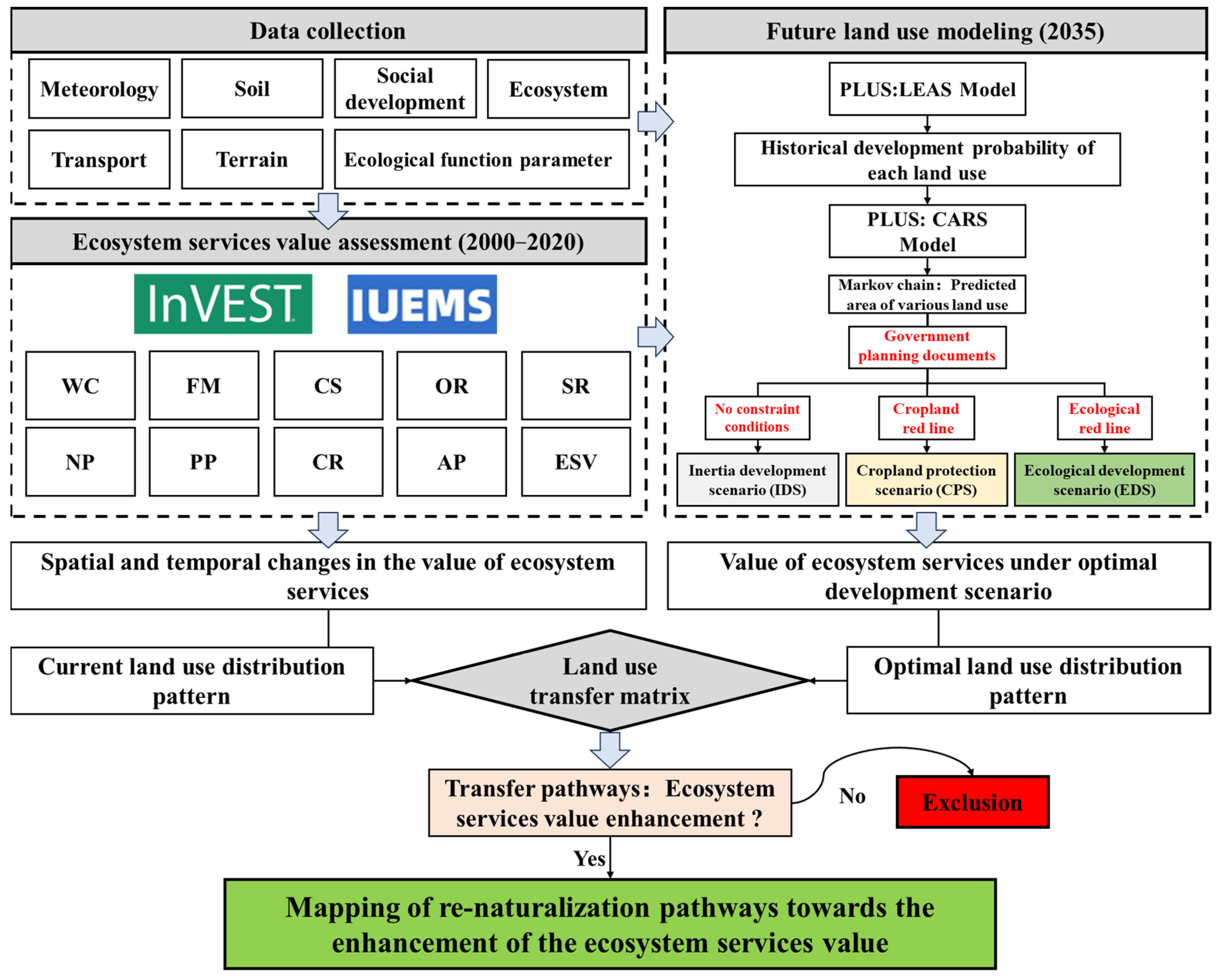
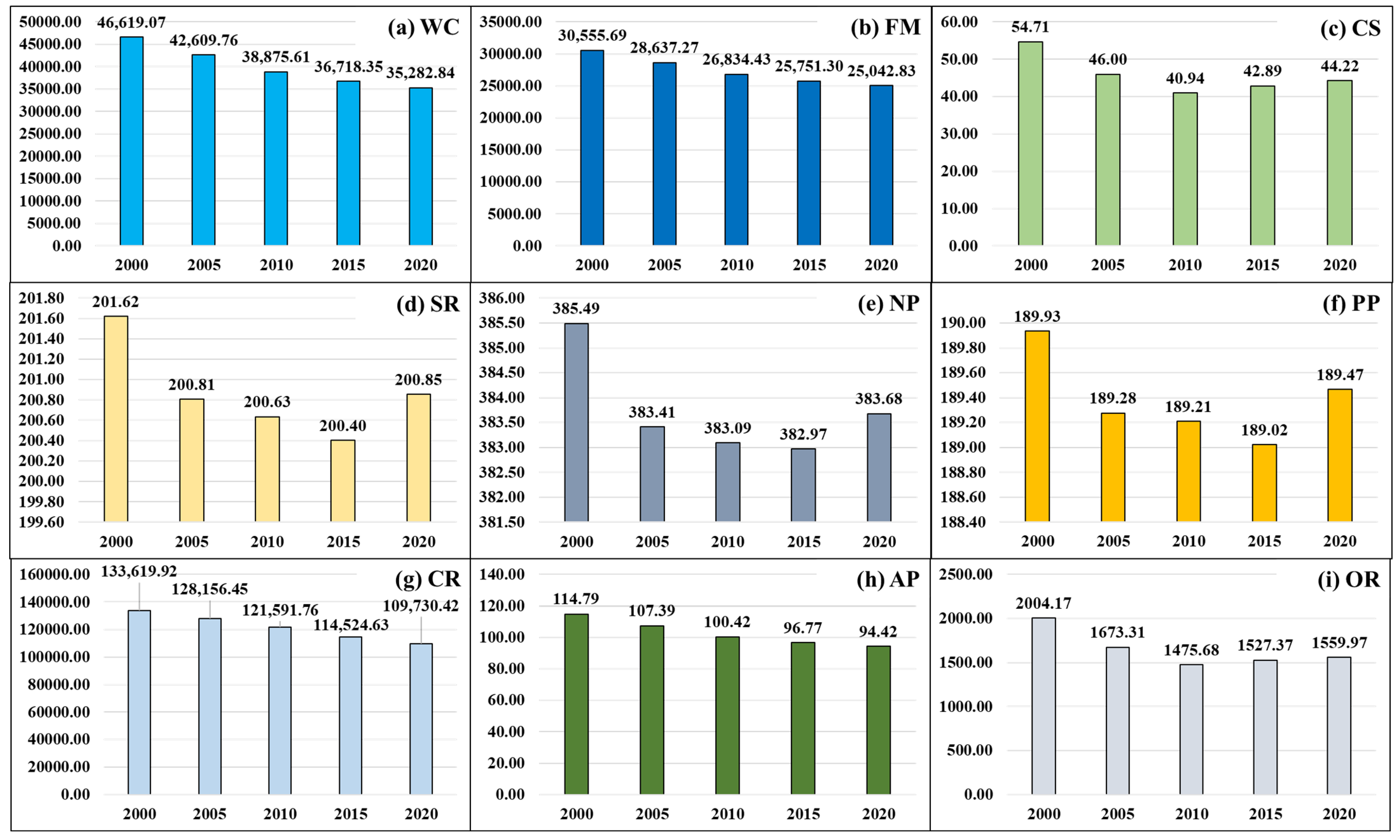

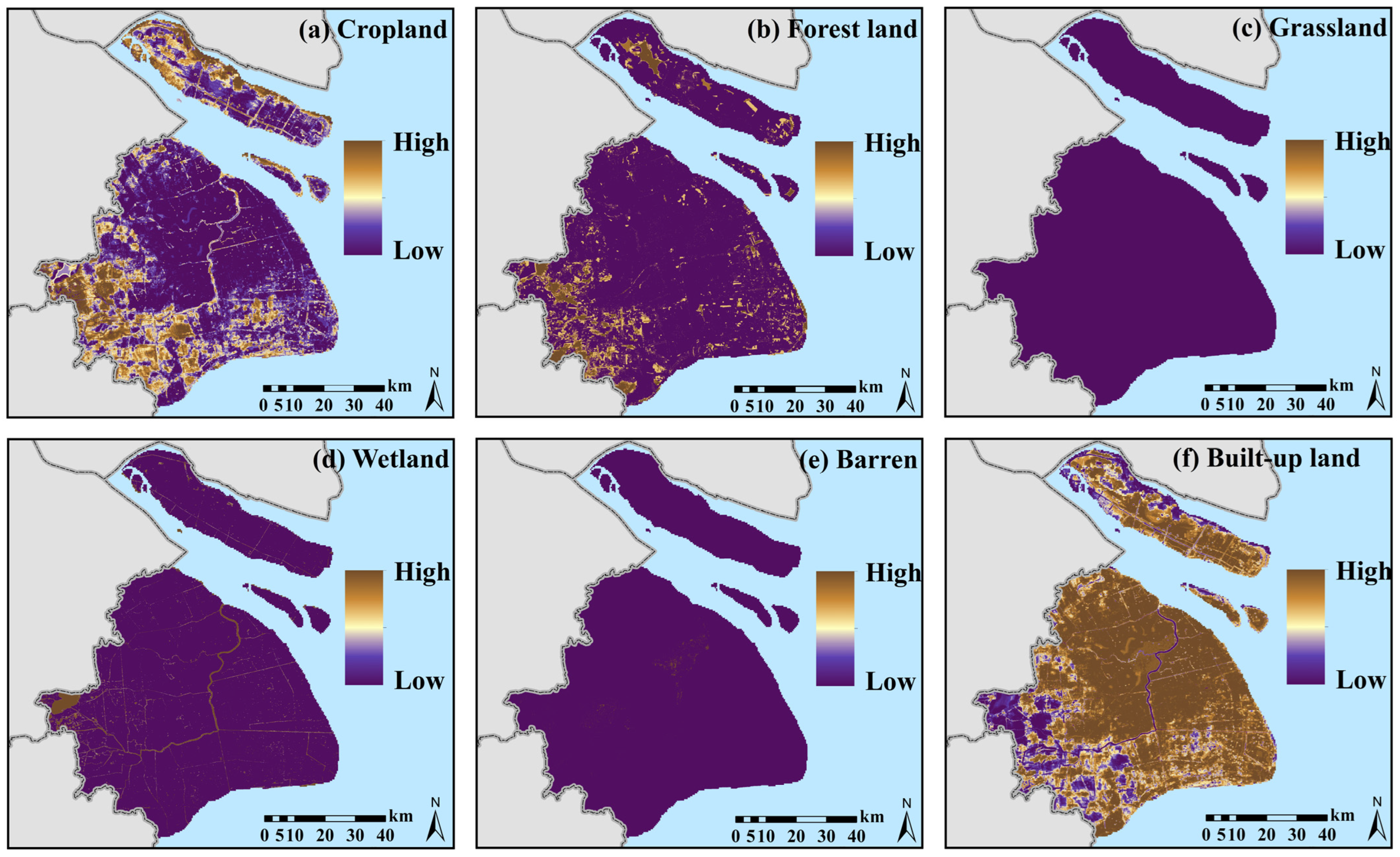


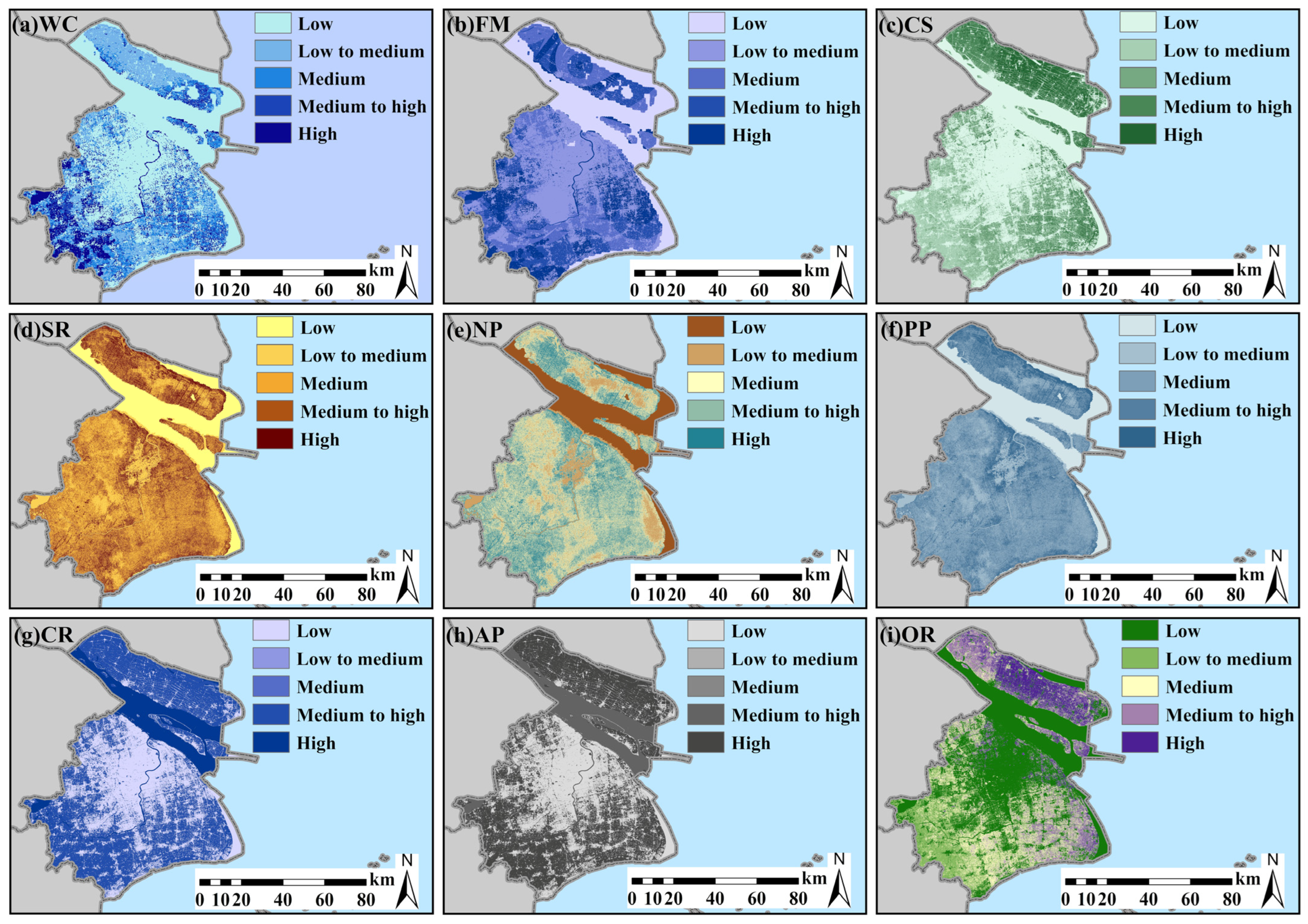
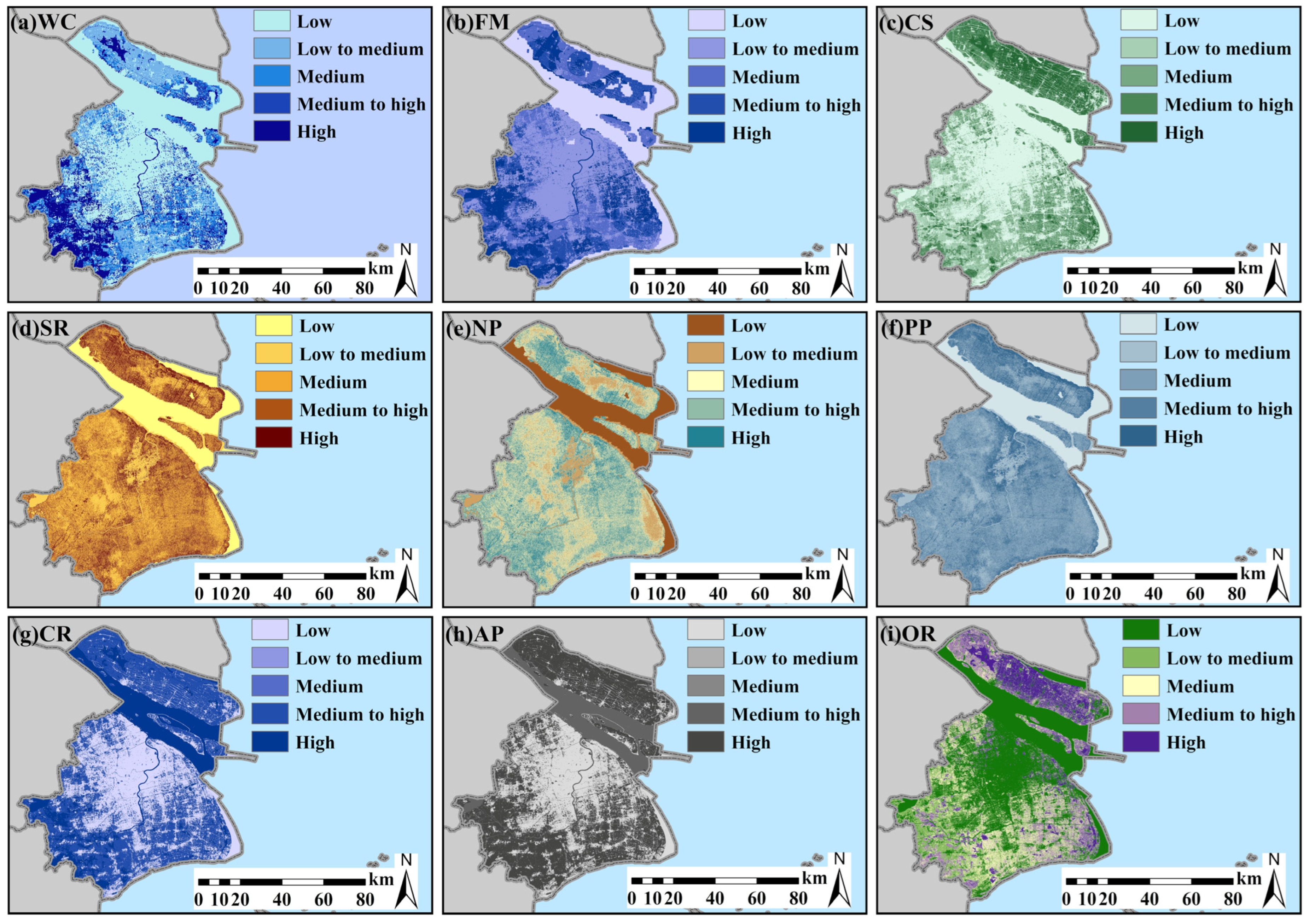
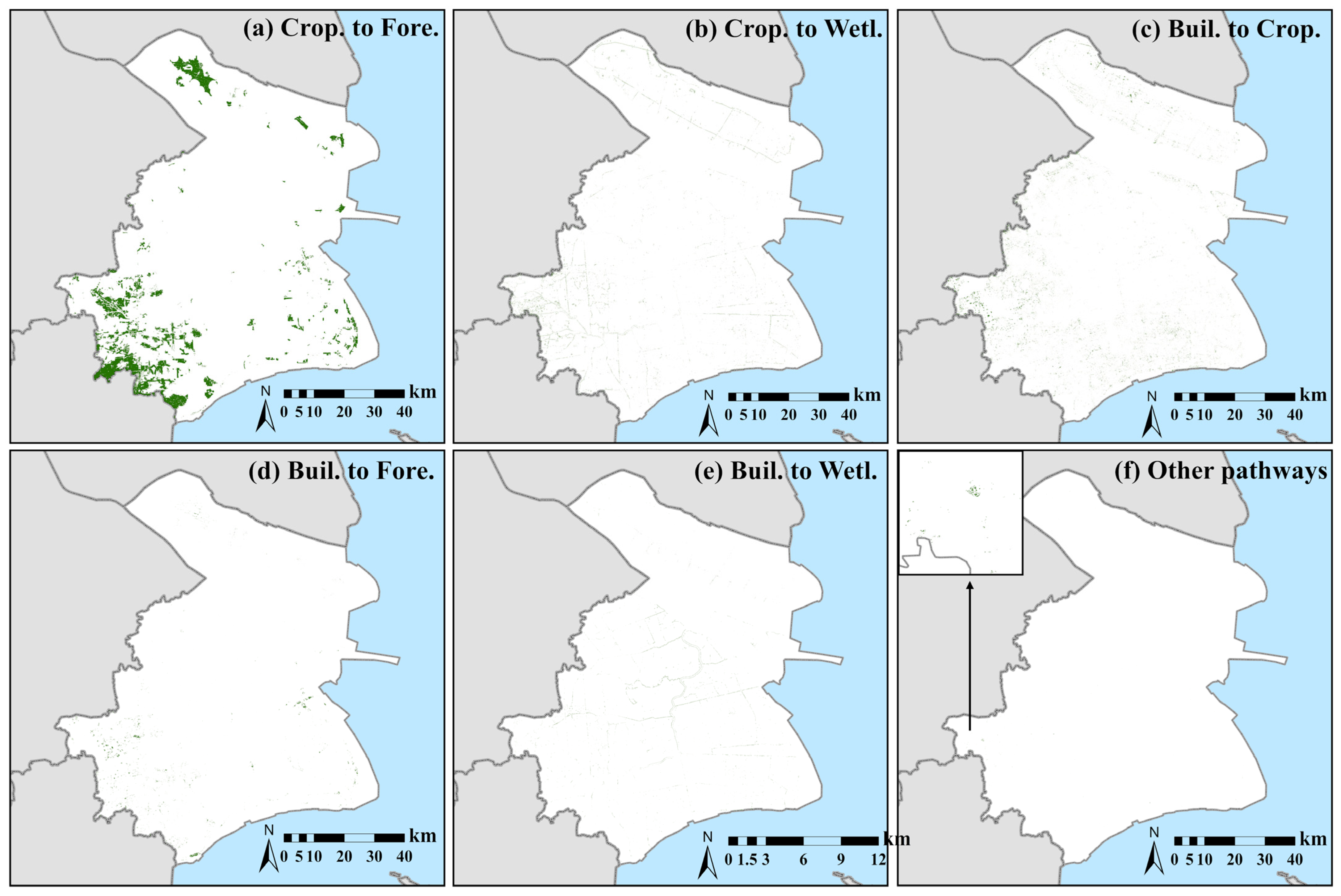
| Type | Potential Driving Forces | Data Source |
|---|---|---|
| Socio-economic factors | Population | Chinese Academy of Sciences Resource and Environmental Data Center (https://www.resdc.cn/), accessed on 1 February 2025 |
| Gross domestic product | ||
| Night-time light | ||
| Proximity to railway station | OpenStreetMap (https://www.openstreetmap.org/), accessed on 1 February 2025 | |
| Proximity to railway | ||
| Proximity to trunk | ||
| Proximity to highway | ||
| Proximity to primary roads | ||
| Proximity to secondary roads | ||
| Proximity to tertiary roads | ||
| Proximity to government | ||
| Climate and environmental factors | Proximity to open water | OpenStreetMap (https://www.openstreetmap.org/), accessed on 1 February 2025 |
| Digital Elevation | ASTER GDEM V3 | |
| Slope | ASTER GDEM V3 | |
| Annual mean temperature | Chinese Academy of Sciences Resource and Environmental Data Center (https://www.resdc.cn/), accessed on 1 February 2025 | |
| Annual precipitation | ||
| Soil type | Harmonized World Soil Database v2.0 (https://www.fao.org/home/en/), accessed on 1 February 2025 |
Disclaimer/Publisher’s Note: The statements, opinions and data contained in all publications are solely those of the individual author(s) and contributor(s) and not of MDPI and/or the editor(s). MDPI and/or the editor(s) disclaim responsibility for any injury to people or property resulting from any ideas, methods, instructions or products referred to in the content. |
© 2025 by the authors. Licensee MDPI, Basel, Switzerland. This article is an open access article distributed under the terms and conditions of the Creative Commons Attribution (CC BY) license (https://creativecommons.org/licenses/by/4.0/).
Share and Cite
Shu, C.; Du, K.; Cai, W.; Cai, Z.; Lin, L. Mapping Re-Naturalization Pathways for Urban Ecological Governance: A Spatial Decision-Support Framework Based on Ecosystem Service Valuation. Land 2025, 14, 917. https://doi.org/10.3390/land14050917
Shu C, Du K, Cai W, Cai Z, Lin L. Mapping Re-Naturalization Pathways for Urban Ecological Governance: A Spatial Decision-Support Framework Based on Ecosystem Service Valuation. Land. 2025; 14(5):917. https://doi.org/10.3390/land14050917
Chicago/Turabian StyleShu, Chengji, Kaiwei Du, Wenbo Cai, Zhengwu Cai, and Li Lin. 2025. "Mapping Re-Naturalization Pathways for Urban Ecological Governance: A Spatial Decision-Support Framework Based on Ecosystem Service Valuation" Land 14, no. 5: 917. https://doi.org/10.3390/land14050917
APA StyleShu, C., Du, K., Cai, W., Cai, Z., & Lin, L. (2025). Mapping Re-Naturalization Pathways for Urban Ecological Governance: A Spatial Decision-Support Framework Based on Ecosystem Service Valuation. Land, 14(5), 917. https://doi.org/10.3390/land14050917








